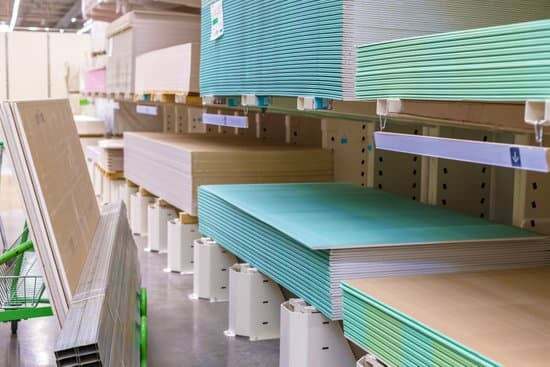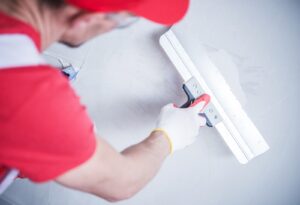If you’re in the middle of a home renovation project, one of the big decisions you’ll have to make is what type of drywall should go up on your walls and ceilings. You may be wondering how much difference does it really make – after all, isn’t all drywall pretty much the same? The fact is that there are now several types of drywall available out there and each has its own set of advantages and disadvantages that can affect how successful your renovation project will be. In this blog post, we’re going to take an in-depth look at all the different types of drywalls that are currently available so you can make an informed decision about which one most closely meets your needs for looks, durability and cost effectiveness.
Standard Drywall
Standard drywall remains the most common choice of drywall for interior walls. Standard drywall, also known as gypsum board, is a versatile building material that comes in various sizes and thicknesses. It is composed of a core made from gypsum, a naturally occurring mineral, sandwiched between layers of paper. This construction provides strength, durability, and fire resistance to the walls and ceilings of homes and buildings.
One of the benefits of standard drywall is its ease of installation. With its lightweight nature, it can be easily transported and maneuvered during the construction process. Additionally, its affordability makes it a popular choice for both residential and commercial projects. Standard drywall is available in a variety of thicknesses, with the most popular being ½ inch and ⅝ inch. Thicker drywall is more soundproof and fire resistant, while thinner drywall is lighter and easier for DIY-ers. You can purchase 2′ x 2′ standard drywall panels at your local home improvement store for minor wall or ceiling repairs.
Furthermore, standard drywall offers flexibility in terms of finishing options. It can be painted, textured, or even adorned with wallpaper to achieve the desired aesthetic for any room. Whether you prefer a smooth and seamless appearance or a textured surface, drywall can be customized to suit your preferences. Additionally, learning how to finish drywall properly allows for a polished and professional look that enhances the overall appeal of the space. With the right techniques and tools, achieving clean edges and smooth seams becomes a straightforward task. This versatility makes drywall a popular choice for both residential and commercial interiors. Additionally, different types of drywall textures, such as knockdown, orange peel, or popcorn, can be applied to add depth and character to a space. These textures not only enhance the visual appeal of walls and ceilings but also help to mask minor imperfections in the surface. This versatility makes drywall a popular choice for both modern and traditional interior designs. Additionally, homeowners can explore cool drywall ideas for homes to elevate the design of their spaces. From creating accent walls with unique geometric patterns to incorporating recessed shelving or niches, drywall can serve as both a functional and decorative element. These creative uses ensure that your walls not only meet structural needs but also enhance the overall character of your interiors.
Ultimately, standard drywall is a practical and cost-effective solution for constructing interior walls and ceilings. Its versatility, ease of installation, and ability to be finished in various ways make it a go-to choice in the construction industry. Additionally, its durability and fire-resistant properties contribute to its widespread use in both residential and commercial buildings. However, over time, damages such as cracks, holes, or water exposure can compromise its functionality and appearance, highlighting the importance of drywall repair to maintain structural integrity and aesthetics. Regular maintenance and timely repairs ensure that drywall remains a reliable and long-lasting component of any interior space. Additionally, its widespread availability and compatibility with various building codes make it a reliable material for both residential and commercial projects. For those new to the process, learning drywall installation stepbystep can simplify construction tasks and ensure professional-looking results. From cutting to size to taping and finishing, this methodical approach minimizes errors and enhances efficiency. Ultimately, standard drywall is a practical and cost-effective solution for constructing interior walls and ceilings. Its versatility, ease of installation, and ability to be finished in various ways make it a go-to choice in the construction industry. To achieve the best results, following proper drywall installation tips and techniques is essential, as this ensures a smooth and professional-looking finish. With proper care and attention to detail, drywall can provide a durable and visually appealing surface that meets the demands of residential and commercial spaces alike.
Fire-Resistant Drywall
When it comes to fire safety, it’s essential to take the necessary precautions to protect your property. That’s where fire-resistant drywall comes in, which is made from fibreglass that helps to slow the spread of flames while offering valuable time for evacuation. Type X fire-resistant drywall is 5/8 in thick and has been designed to withstand high temperatures and slow the spread of fire (around a 1 hour protection period), giving you and your loved ones more time to escape in the event of a fire. Type X drywall is particularly handy in high-risk areas, such as kitchens, utility rooms or garages, where the likelihood of fire is higher. Type C fire-resistant drywall is similar, but it doesn’t shrink while burning. It provides both fire resistance and soundproofing, making it a versatile option for both noise prevention and safety and perfect for areas like the bedroom or home theatre.
That said, no material is completely fireproof, but fire-resistant drywall serves as a critical barrier in protecting your property from the devastating effects of fire.
Mould Resistant Drywall
Mould and mildew growth is a common issue in bathrooms and other damp areas of a home. This can not only create an unpleasant smell, but it can also compromise the structural integrity of the walls. Steam from showers and baths wreak havoc on standard drywall, causing it to weaken, crumble and become a breeding ground for mould. Mould-resistant drywall is specially formulated and designed with a water-repellant core to prevent the growth of mould and mildew in high humidity conditions. Not only does this give you peace of mind, but it also helps to maintain the longevity of your interior walls. Mould resistant drywall is colour coded blue or green so it’s easy to identify if you’re not sure. So if you’re looking for a solution to combat mould in your bathroom, laundry room, or even kitchen back splash, consider mould resistant drywall as a practical and effective option.
Soundproof Drywall
Are noisy neighbors or a bustling street causing disruptions to your peaceful home? If so, soundproof drywall may be the solution you need. This innovative construction material consists of a layered design, with a gypsum core panel and a viscoelastic polymer sandwiched between two sheets of high-density fiberglass matting. The result is a thicker and heavier panel that absorbs and dampens sound vibrations, preventing them from traveling between walls. This makes it an ideal choice for bedrooms, home theatres, or any room where peace and quiet is a must. Soundproof drywall also does not compromise the aesthetic of your home — it can be finished and painted just like standard drywall. With soundproof drywall, you can enjoy your home in peace, free from unwanted disturbances.
Paperless Drywall
Paperless drywall is revolutionizing the way we think about traditional building materials. Instead of the conventional paper facing that we associate with traditional drywall, paperless drywall technology replaces it with fiberglass matting. This innovative advancement is not just a more environmentally friendly option, but it also boasts superior resistance to mould, moisture, and fire compared to traditional drywall. Traditional drywall can be vulnerable to water damage, leading to sagging, mold growth, and deterioration. In contrast, paperless drywall stands strong in humid environments. This makes it an ideal choice for areas prone to high humidity, such as basements, kitchens, and bathrooms, where durability and longevity are paramount. By significantly reducing the risk of mold and water-related damage, paperless drywall is becoming a key material for modern construction projects. For those exploring innovative building solutions or asking what is a blog to learn more about construction trends, this groundbreaking technology is frequently discussed as an industry game-changer.
Paperless drywall is perfect for those who are looking for better construction materials that can improve the overall quality and durability of their homes or commercial properties. It’s easy to cut, handle and install, since the absence of paper means it’s less prone to tearing or creasing during installation. With its exceptional durability and diverse range of applications, it’s no surprise that paperless drywall is becoming a favorite among builders and homeowners alike.
What type of drywall is right for your project?
When it comes to selecting the right type of drywall for your renovation or home build project, the desired results should be your main consideration. Different types of drywall are suitable for different purposes, whether it’s soundproofing a room or moisture resistance in areas like bathrooms or kitchens. Some are also designed to be fire-resistant, while others offer better insulation. It is important to evaluate what your end goal is and choose accordingly. Whether you’re looking for aesthetic appeal or compliance with specific regulations, the right choice of drywall will enhance the results of your build. Take the time to research and consult with professionals like Drywall Medic if necessary to ensure that you get the best results possible.
With Drywall Medic, you can trust that all your frames will be set up in line with existing building regulations and industry standards. You can rest assured knowing that your projects are being handled by experienced and certified professionals who value quality over speed, for a safe finish every time. Contact us to discuss details regarding specific projects or further information about our services.




